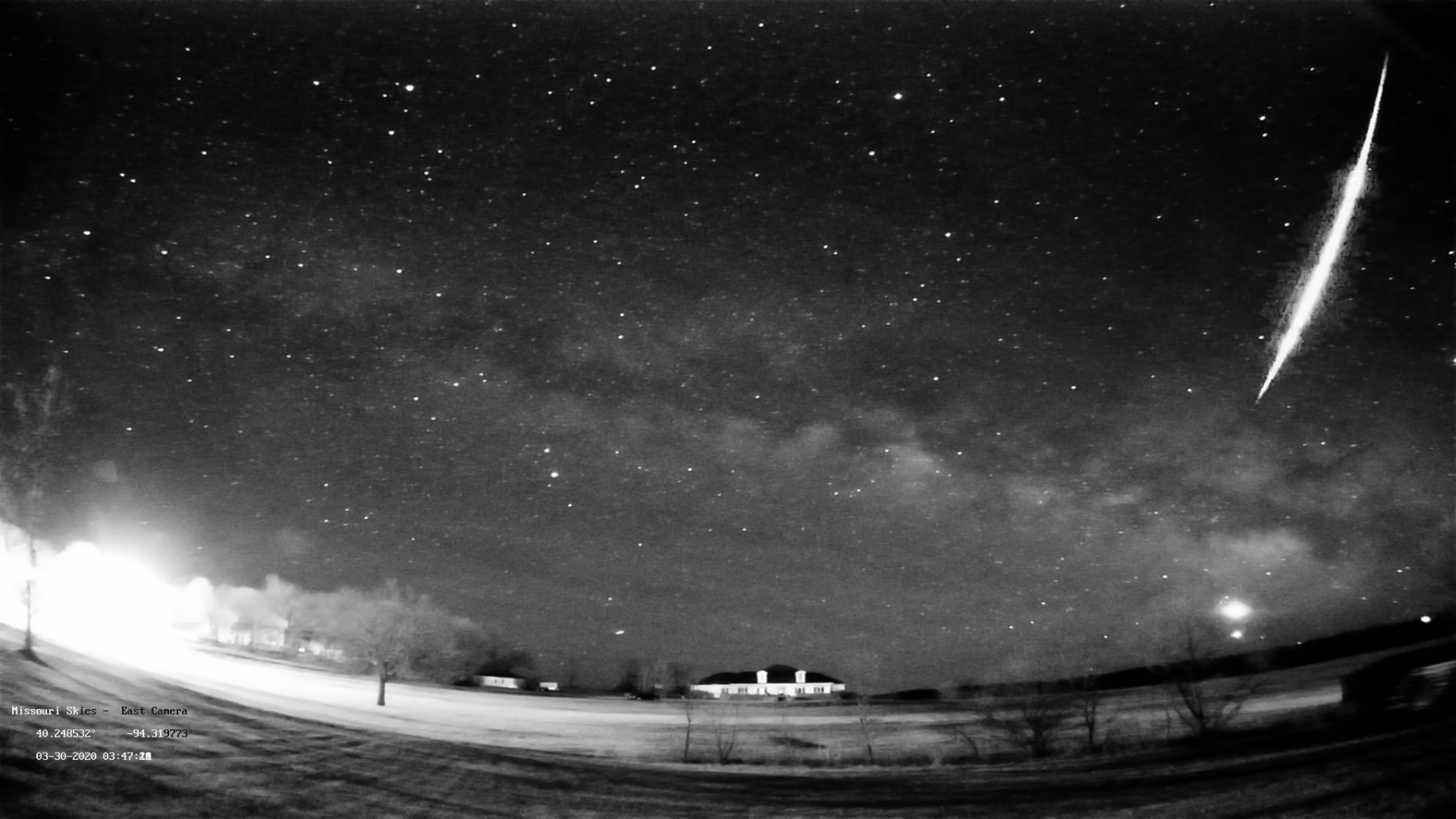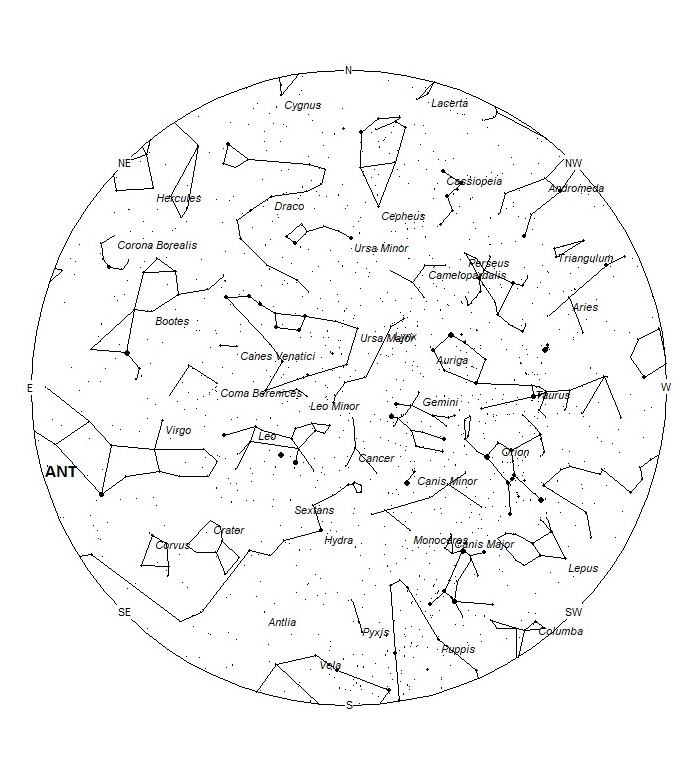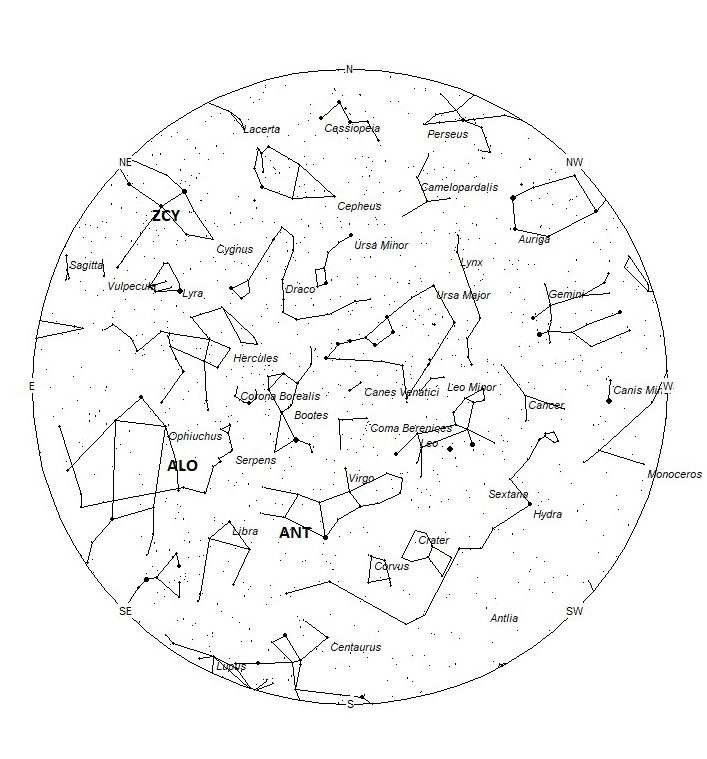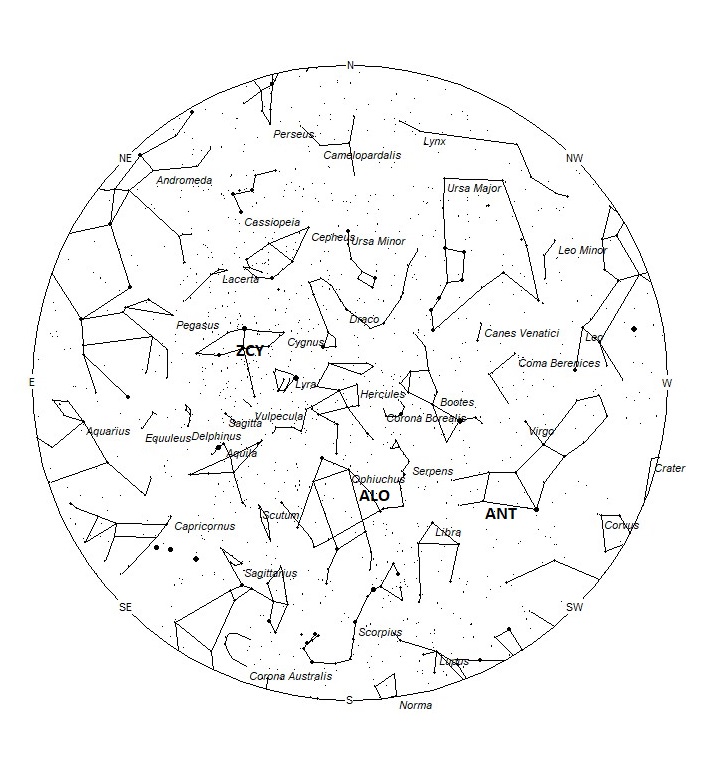
During this period the moon reaches its full phase on Tuesday April 7th. At this time the moon lies opposite the sun and will be above the horizon all night long. This weekend the waxing gibbous moon will set during the morning hours allowing meteor observers a short window of opportunity to view under dark skies just before dawn. The estimated total hourly meteor rates for evening observers this week is near 3 for those viewing from the southern hemisphere and 2 for those located north of the equator. For morning observers, the estimated total hourly rates should be near 14 as seen from tropical southern locations (25S) and 9 as seen from mid-northern latitudes (45N). The actual rates will also depend on factors such as personal light and motion perception, local weather conditions, alertness and experience in watching meteor activity. Evening rates are reduced by moonlight. Note that the hourly rates listed below are estimates as viewed from dark sky sites away from urban light sources. Observers viewing from urban areas will see less activity as only the brighter meteors will be visible from such locations.
The radiant (the area of the sky where meteors appear to shoot from) positions and rates listed below are exact for Saturday night/Sunday morning April 4/5. These positions do not change greatly day to day so the listed coordinates may be used during this entire period. Most star atlases (available at science stores and planetariums) will provide maps with grid lines of the celestial coordinates so that you may find out exactly where these positions are located in the sky. A planisphere or computer planetarium program is also useful in showing the sky at any time of night on any date of the year. Activity from each radiant is best seen when it is positioned highest in the sky, either due north or south along the meridian, depending on your latitude. It must be remembered that meteor activity is rarely seen at the radiant position. Rather they shoot outwards from the radiant, so it is best to center your field of view so that the radiant lies at the edge and not the center. Viewing there will allow you to easily trace the path of each meteor back to the radiant (if it is a shower member) or in another direction if it is a sporadic. Meteor activity is not seen from radiants that are located below the horizon. The positions below are listed in a west to east manner in order of right ascension (celestial longitude). The positions listed first are located further west therefore are accessible earlier in the night while those listed further down the list rise later in the night.
These sources of meteoric activity are expected to be active this week.
.
The center of the large Anthelion (ANT) radiant is currently located at 13:52 (208) -09. This position lies in eastern Virgo, 5 degrees east of the 1st magnitude star known as Spica (alpha Virginis). Due to the large size of this radiant, Anthelion activity may also appear from western Libra as well as Virgo. This radiant is best placed near 0200 local daylight saving time (LDST), when it lies on the meridian and is located highest in the sky. Rates at this time should be near 2 per hour no matter your location. With an entry velocity of 30 km/sec., the average Anthelion meteor would be of slow velocity.
The April lambda Ophiuchids (ALO) were first detected by Damir Šegon and the Croatian Meteor Network team based on studying SonotaCo and CMN observations (SonotaCo 2007-2011, CMN 2007-2010). This source is currently listed among the “working” showers of the International Astronomical Union. A recent article by Masahiro Koseki in WGN (IMO Journal) suggests that this source and other working showers may be strong enough to be observed by visual means. The exact stream duration is not available, but this source should be active for a least a week centered on the April 6th maximum. The radiant position at maximum is 16:20 (245) +01. This area of the sky is located southeastern Serpens Caput, 2 degrees southwest of the 4th magnitude star known as Marfik (lambda Ophiuchi). This radiant is best placed near 0400 LDST, when it lies on the meridian and is located highest in the sky. Rates at this time should be near 1 per hour no matter your location. With an entry velocity of 56 km/sec., the average meteor from this source would be of fast velocity.
The Zeta Cygnids (ZCY) were first detected by Zdenek Sekanina and mentioned in his article on a study of radio streams. These meteors are active from April 3-10 with maximum activity occurring on the 6th. At maximum the radiant is located at 20:08 (302) +40. This area of the sky is located in central Cygnus just 2 degrees west of the 2nd magnitude star known as Sadr (gamma Cygni). Note that this position is nowhere close to the star zeta Cygni which lies on the east side of the constellation. This usually occurs when activity is suspected from a radiant and further studies indicate a radiant in another position. Rather than correcting the name the original name is kept so that the association of earlier observations and that of newer data remains intact. This may confuse new observers but luckily this does not occur often among the lists of radiants. This radiant is best placed during the last hour before dawn when it lies highest above the horizon in a dark sky. Rates at maximum should be near 1 per hour just before dawn as seen from mid-northern latitudes. Unfortunately, these meteors are not well seen from south of the equator. With an entry velocity of 40 km/sec., the average meteor from this source would be of medium velocity.
The delta Pavonids (DPA) were first noticed by Michael Buhagiar, Perth, Western Australia, during his observations from 1969-1980. Activity was first thought to be limited to the first week of April but was later expanded from March 11 through April 16. Most of the activity is confined to the period from March 30 through April 6. The position of the radiant is expected to be located near 21:04 (316) -64. This position lies in eastern Pavo, 2 degrees north of the 3rd magnitude star known as beta Pavonis. This radiant is best placed in the sky during the last dark hour prior to dawn. Due to the southern location of the radiant, these meteors are not well seen north of the equator. Rates are variable from this source. With an entry velocity of 58 km/sec., the average meteor from this source would be swift.
As seen from the mid-northern hemisphere (45N) one would expect to see approximately 5 sporadic meteors per hour during the last hour before dawn as seen from rural observing sites. Evening rates would be near 1 per hour. As seen from the tropical southern latitudes (25S), morning rates would be near 8 per hour as seen from rural observing sites and 2 per hour during the evening hours. Locations between these two extremes would see activity between the listed figures. Evening rates are reduced due to moonlight.
| SHOWER | DATE OF MAXIMUM ACTIVITY | CELESTIAL POSITION | ENTRY VELOCITY | CULMINATION | HOURLY RATE | CLASS |
| RA (RA in Deg.) DEC | Km/Sec | Local Daylight Saving Time | North-South | |||
| Anthelion (ANT) | – | 13:24 (201) -09 | 30 | 02:00 | 2 – 2 | II |
| April lambda Ophiuchids (ALO) | Apr 06 | 16:20 (245) +01 | 56 | 04:00 | 1 – 1 | IV |
| Zeta Cygnids (ZCY) | Apr 06 | 20:08 (302) +40 | 40 | 08:00 | 1 – <1 | IV |
| delta Pavonids (DPA) | Mar 30 | 21:04 (316) -64 | 58 | 09:00 | <1 – 1 | III |
 American Meteor Society
American Meteor Society



Just after 7pm today, we saw a beautiful blue horizontal flying meteor. It was still light out and it looked like a bright blue streak of light that broke off into 6 or 8 smaller pieces before disappearing. It was amazing color like a huge gemstone with a long tail of light. We live in rural Florida.
Hi Holly – we live in Stuart, FL, I’m guessing we saw the same meteor! Very cool!
Caught sight of one 3:10am pst in Central Oregon by accident.
Last night (early morning) around 3:52am April 10th 2020., I was driving on KS-7 N on my way to work. On my way there , I happened to have looked up at the clear starry sky(no light pollution), and to my astonishment I saw a GREEN Flash. Looking like a sideways tear-drop but florescent green It trailed across the sky. It left a little glowing tail but that faded mere moments after comet flashed past my direct view. It was astonishing.
I have seen a huge fire ball with long tail like rainbow on April 7 (7:30 pm pakistan time) I have seen it’s dark flight when it broken in small peices. It’s started above Rawalpindi Pakistan and landed any where in POK Kashmir.